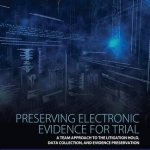Preserving Electronic Evidence for Trial: A Team Approach to the Litigation Hold, Data Collection, and Evidence Preservation
BookThis item doesn’t have any media yet
2016 | Computing & IT
The ability to preserve electronic evidence is critical to presenting a solid case for civil litigation, as well as in criminal and regulatory investigations. Preserving Electronic Evidence for Trial provides everyone connected with digital forensics investigation and litigation with a clear and practical hands-on guide to the best practices in preserving electronic evidence. Corporate management personnel (legal & IT) and outside counsel need reliable processes for the litigation hold - identifying, locating, and preserving electronic evidence. Preserving Electronic Evidence for Trial provides the road map, showing you how to organize the digital evidence team before the crisis, not in the middle of litigation. This practice handbook by an internationally known digital forensics expert and an experienced litigator focuses on what corporate and litigation counsel as well as IT managers and forensic consultants need to know to communicate effectively about electronic evidence. You will find tips on how all your team members can get up to speed on each other's areas of specialization before a crisis arises.
The result is a plan to effectively identify and pre-train the critical electronic-evidence team members. You will be ready to lead the team to success when a triggering event indicates that litigation is likely, by knowing what to ask in coordinating effectively with litigation counsel and forensic consultants throughout the litigation progress. Your team can also be ready for action in various business strategies, such as merger evaluation and non-litigation conflict resolution.
Related Items:
| Published by | Elsevier Science Publishing Co Inc |
| Edition | Unknown |
| ISBN | 9780128093351 |
| Language | N/A |
Images And Data Courtesy Of: Elsevier Science Publishing Co Inc.
This content (including text, images, videos and other media) is published and used in accordance
with Fair Use.
